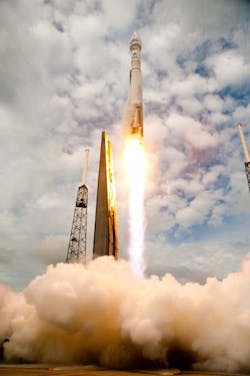A Rundown of MAVEN: NASA’s Mission to Study Mars’ Upper Atmosphere
MAVEN will join the other orbiters and rovers that are currently exploring Mars in preparation for human missions set for the 2030s. The main goal of the spacecraft will be to analyze and measure the current rates of atmospheric loss in hopes that it will shed light on how Mars transitioned from a warm, wet planet to the dry, desert-like one it is today. That evolution was confirmed by the Curiosity rover’s Thermal and Evolved-Gas Analyzer (TEGA) after identifying a water sample. It will be the basis of MAVEN’s test theory that the atmosphere eroded over time, leaving the planet unable to maintain liquid water.
To ensure that it provides a more stable signal than previous spacecraft, the MAVEN is outfitted with an upgraded high-gain antenna (HGA). The fixed-HGA, which has a 2-m, dual-reflector X-band downlink, boasts rates to 550 kb/s. Unlike the gimbaled antennas aboard the Mars Reconnaissance Orbiter (MRO) and the Mars Global Surveyor (MGS), this antenna is fixed along the craft’s +Z-axis. Because it will therefore face some positioning problems, a low-gain antenna (LGA) will be used when the HGA is unavailable for Earth communications.
This mission’s data-collection tasks will be possible thanks to MAVEN’s trio of instrument suites. The Particles and Fields Package, developed by the Berkley Space Sciences Laboratory at the University of California, contains six individual instruments that will characterize the solar wind and ionosphere of the planet. The Remote Sensing Package, built by the Laboratory for Atmospheric and Space Physics (LASP) at the University of Colorado at Boulder, will determine the global characteristics of the upper atmosphere and ionosphere. Lastly, the Neutral Gas and Ion Mass Spectrometer, built by NASA’s Goddard Space Flight Center, will measure the composition and isotopes of neutrals and ions.
This file type includes high resolution graphics and schematics when applicapable.
Mission scientists hope to collect data to help determine the role that the loss of volatile compounds, such as carbon dioxide and nitrogen dioxide, had on changing Mars’ atmosphere. The electronics aboard the spacecraft are shielded in a multi-layer insulation (MLI) material that will safeguard them from extreme temperatures. Developed by DUNMORE, the insulation films are lightweight, reflective, and assembled into many thin layers to provide the necessary thermal protection.
MAVEN was launched in November 2013 from Cape Canaveral Air Force Station aboard a United Launch Alliance Atlas V-401 rocket. It successfully separated from the rocket’s Centaur upper stage 53 minutes after launch, soon after deploying its two solar arrays and beginning to produce power. Initial communication was then obtained by the mission’s flight operations team at the Lockheed Martin Space Systems Company’s facility near Denver, Colorado.
With all signs pointing to fully healthy major subsystems, the spacecraft is intended to arrive at Mars on September 22, 2014. It will spend a year performing its mission on Mars. For 10 weeks before its arrival, MAVEN will power on and check out each of its eight instruments to make sure that they are working properly. Upon reaching Mars, the spacecraft will execute an orbit insertion maneuver by firing six thrusters, which will allow it to be captured by the planet’s orbit. The following five weeks will involve MAVEN establishing itself in orbit to properly conduct all operations before the one-year primary mission begins.
About the Author
Iliza Sokol
Associate Digital Editor
Iliza joined the Penton Media group in 2013 after graduating from the Fashion Institute of Technology with a BS in Advertising and Marketing Communications. Prior to joining the staff, she worked at NYLON Magazine and a ghostwriting firm based in New York.


